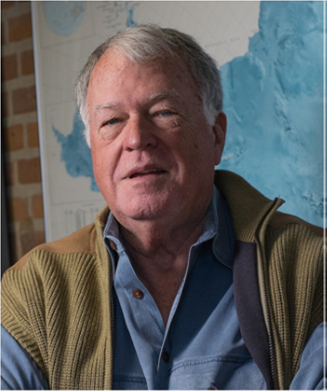Dr. John Anderson, 2019 Doris Malkin Curtis Medal
 In recognition of outstanding contributions to the understanding of sedimentology, marine geology, and cryosphere studies in the Gulf of Mexico and world oceans
In recognition of outstanding contributions to the understanding of sedimentology, marine geology, and cryosphere studies in the Gulf of Mexico and world oceans
Dr. John B. Anderson, recipient of the GCSSEPM 2019 Doris Malkin Curtis Medal, was born in Alabama, where he first developed his life-long interest in the Gulf Coast. He studied geology at the University of South Alabama and then moved to Albuquerque for an M.S. at University of New Mexico. At UNM, he worked mapping the area around the Nacimiento Uplift, a temporary change from coastal and marine work. After New Mexico, John moved to Tallahassee and completed his Ph.D.in 1972 at Florida State University, a school with a great history of Antarctic research. There, he began what would be a research project that, in a broad sense, has lasted nearly 50 years. His dissertation focused on glacial-marine sediments in the Weddell Sea, Antarctica—work that still informs our understanding of the area today. The dissertation itself includes beautiful drawings of forams that many of us admire as art that we can't achieve ourselves other than by SEM.
John's first position was as an assistant professor at Hope College, in Holland, MI. He taught geology there for three years and studied the nearby lakes and environmental geology. In 1975, he joined the faculty at Rice University in Houston, TX, and he spent the rest of his career there, retiring as the Maurice Ewing Professor of Oceanography. At Rice, John taught courses in sedimentology, stratigraphy, marine geology, glacial geology, and seminars focused specifically on Antarctica or the Gulf Coast, teaching just about every student to come through the department studying geology. While at Rice, he led many field trips back to New Mexico, focused on the sedimentary rocks in the area where he had once been a student. John spent much of his career applying sedimentology, geophysics, paleontology, and geochemistry to study the history of ice sheets and to learn how they behave, providing essential knowledge for understanding changes in sea level. During this work John led 24 scientific expeditions to the Southern Ocean as chief scientist or co-chief. His work on the glacial history of Antarctica has shown the ice sheet exhibited both long-term stability and short-term rapid retreats, developing the physical understanding that humans could trigger changes that would be dangerous for coasts. At the same time, he has studied the coast along the northern Gulf of Mexico, with many projects that have built not only our understanding of the long-term development of the margin, but also how the coast responds to both storms and sea-level rise. And, by studying the past and ongoing response of the Texas shelf to the rising sea level, he informs decision makers tasked with adapting to the changes.
John successfully supervised ~64 students completing research for their master’s degree, Ph.D., or both. Many of the students, along with scores of undergraduates and guests from various other universities, were able to participate in cruises to the Antarctic, where it became clear how much John enjoyed being at sea. Some were equally inspired by the experience of being in Antarctica and found it launched their careers, although there were certainly a few that discovered they were not suited to being at sea and decided to pursue future land-based studies. Like John, many students had projects in both Antarctica and in the Gulf of Mexico as part of their research, allowing each student to see the impact and interconnectedness of the two programs. Fourteen of John's graduate students went on to hold faculty positions and have supervised dozens of additional students studying glacial history, sea-level change, coastal geology, sediment transport, and sequence stratigraphy, among other topics. A few dozen of John's former students have gone to work in the oil industry, in Houston and around the world; these students are equally successful in their careers and are influencing the petroleum industry, in part by recruiting later generations of students to internships and jobs. Other past students have gone onto work in science education and outreach, Antarctic logistics management, and the environmental industry. John has received many awards throughout his career, including the GCAGS Outstanding Educator Award (1992), Graduate Teacher of the Year at Rice University (1995), the SEPM (Society for Sedimentary Geology) Shepard Medal (2007), and election to Fellowship in the Geological Society of America (1995). He was an AAPG Haas-Pratt Distinguished Lecturer and the president of the Society of Sedimentary Geology, among many other roles and distinctions. Throughout his life, going back to his start in Alabama, John's wife, Doris, has been by his side. After many years of holidays when John was in the Antarctic, Doris joined a cruise off of the coast of Chile and took her turn as a watch stander along with all the students. In Texas, many field trips have ended with splitting cores and washing equipment in their yard, or happy hour on the deck, so that dozens of geologists have been able to enjoy their perch on Galveston Island with a view of the bay. John retired officially from Rice in 2018. However, as I write this, John is with me, two additional alumni from his lab, each of the three of us with our own graduate students, all describing sediment cores in a repository on the West Coast. He is continuing to share his insight along with inspiring an additional generation of researchers and we all hope he will keep joining us.
Julia Smith Wellner
University of Houston
